The first (ΔiH1) and second (ΔiH2) ionisation enthalpies (inkJmol−1) and the (ΔegHө) electron gain enthalpy (inkJmol−1) of a few elements are given below:
Elements(ΔiH1)(ΔiH2)ΔegHөI5207300−60II4193051−48III16813374−328IV10081846−295V23725251+48VI7381451−40
Which of the above elements is likely to be
a. the least reactive element.
b. the most reactive metal.
c. the most reactive non-metal.
d. the least reactive non-metal.
e. the metal which can form a stable binary halide of the formula MX2 (X=halogen).
f. the metal which can form a predominantly stable covalent halide of the formula MX(X=halogen).
To solve the problem, we will analyze the given data for the elements I, II, III, IV, V, and VI based on their ionization enthalpies and electron gain enthalpy.
1. Identify the least reactive element:
- The least reactive element will have the highest first ionization enthalpy and a positive or less negative electron gain enthalpy.
- From the data:
- Element I: ΔiH1=520, ΔiH2=7300, ΔegH∘=−60
- Element II: ΔiH1=419, ΔiH2=3051, ΔegH∘=−48
- Element III: ΔiH1=1681, ΔiH2=3374, ΔegH∘=−328
- Element IV: ΔiH1=1008, ΔiH2=1846, ΔegH∘=−295
- Element V: ΔiH1=2372, ΔiH2=5251, ΔegH∘=+48
- Element VI: ΔiH1=738, ΔiH2=1451, ΔegH∘=−40
- Element V has the highest first ionization enthalpy (2372 kJ/mol) and a positive electron gain enthalpy, making it the least reactive element.
Answer: Element V is the least reactive element.
2. Identify the most reactive metal:
- The most reactive metal will have the lowest first ionization enthalpy and a low electron gain enthalpy.
- Element II has the lowest first ionization enthalpy (419 kJ/mol) and a relatively low electron gain enthalpy (-48 kJ/mol).
Answer: Element II is the most reactive metal.
3. Identify the most reactive non-metal:
- The most reactive non-metal will have a high negative electron gain enthalpy.
- Element III has the most negative electron gain enthalpy (-328 kJ/mol), indicating a strong tendency to gain electrons.
Answer: Element III is the most reactive non-metal.
4. Identify the least reactive non-metal:
- The least reactive non-metal will have a high electron gain enthalpy but not a very high first ionization enthalpy.
- Element IV has a relatively high electron gain enthalpy (-295 kJ/mol) and a moderate first ionization enthalpy (1008 kJ/mol).
Answer: Element IV is the least reactive non-metal.
5. Identify the metal that can form a stable binary halide of the formula MX2:
- For a metal to form a stable binary halide of the formula MX2, it should have a low first ionization enthalpy and a higher second ionization enthalpy.
- Element VI has a low first ionization enthalpy (738 kJ/mol) and a higher second ionization enthalpy (1451 kJ/mol).
Answer: Element VI can form a stable binary halide of the formula MX2.
6. Identify the metal that can form a predominantly stable covalent halide of the formula MX:
- For this, we look for a metal with a low first ionization enthalpy and a very high second ionization enthalpy.
- Element I has a low first ionization enthalpy (520 kJ/mol) and a very high second ionization enthalpy (7300 kJ/mol).
Answer: Element I can form a predominantly stable covalent halide of the formula MX.
Summary of Answers:
a. Least reactive element: Element V
b. Most reactive metal: Element II
c. Most reactive non-metal: Element III
d. Least reactive non-metal: Element IV
e. Metal forming stable binary halide MX2: Element VI
f. Metal forming stable covalent halide MX: Element I
- The least reactive element will have the highest first ionization enthalpy and a positive or less negative electron gain enthalpy.
- From the data:
- Element I: ΔiH1=520, ΔiH2=7300, ΔegH∘=−60
- Element II: ΔiH1=419, ΔiH2=3051, ΔegH∘=−48
- Element III: ΔiH1=1681, ΔiH2=3374, ΔegH∘=−328
- Element IV: ΔiH1=1008, ΔiH2=1846, ΔegH∘=−295
- Element V: ΔiH1=2372, ΔiH2=5251, ΔegH∘=+48
- Element VI: ΔiH1=738, ΔiH2=1451, ΔegH∘=−40
- Element V has the highest first ionization enthalpy (2372 kJ/mol) and a positive electron gain enthalpy, making it the least reactive element.
- The most reactive metal will have the lowest first ionization enthalpy and a low electron gain enthalpy.
- Element II has the lowest first ionization enthalpy (419 kJ/mol) and a relatively low electron gain enthalpy (-48 kJ/mol).
Answer: Element II is the most reactive metal.
- The most reactive non-metal will have a high negative electron gain enthalpy.
- Element III has the most negative electron gain enthalpy (-328 kJ/mol), indicating a strong tendency to gain electrons.
Answer: Element III is the most reactive non-metal.
- The least reactive non-metal will have a high electron gain enthalpy but not a very high first ionization enthalpy.
- Element IV has a relatively high electron gain enthalpy (-295 kJ/mol) and a moderate first ionization enthalpy (1008 kJ/mol).
Answer: Element IV is the least reactive non-metal.
- For a metal to form a stable binary halide of the formula MX2, it should have a low first ionization enthalpy and a higher second ionization enthalpy.
- Element VI has a low first ionization enthalpy (738 kJ/mol) and a higher second ionization enthalpy (1451 kJ/mol).
Answer: Element VI can form a stable binary halide of the formula MX2.
- For this, we look for a metal with a low first ionization enthalpy and a very high second ionization enthalpy.
- Element I has a low first ionization enthalpy (520 kJ/mol) and a very high second ionization enthalpy (7300 kJ/mol).
Answer: Element I can form a predominantly stable covalent halide of the formula MX.
a. Least reactive element: Element V
b. Most reactive metal: Element II
c. Most reactive non-metal: Element III
d. Least reactive non-metal: Element IV
e. Metal forming stable binary halide MX2: Element VI
f. Metal forming stable covalent halide MX: Element I
Topper's Solved these Questions
Similar Questions
The first (ΔH1) and second (ΔH2) ionisation enthalpies (in kJmol−1) and the (ΔHeg) electron gain enthalpy (in kJmol−1) of a elements are given below:
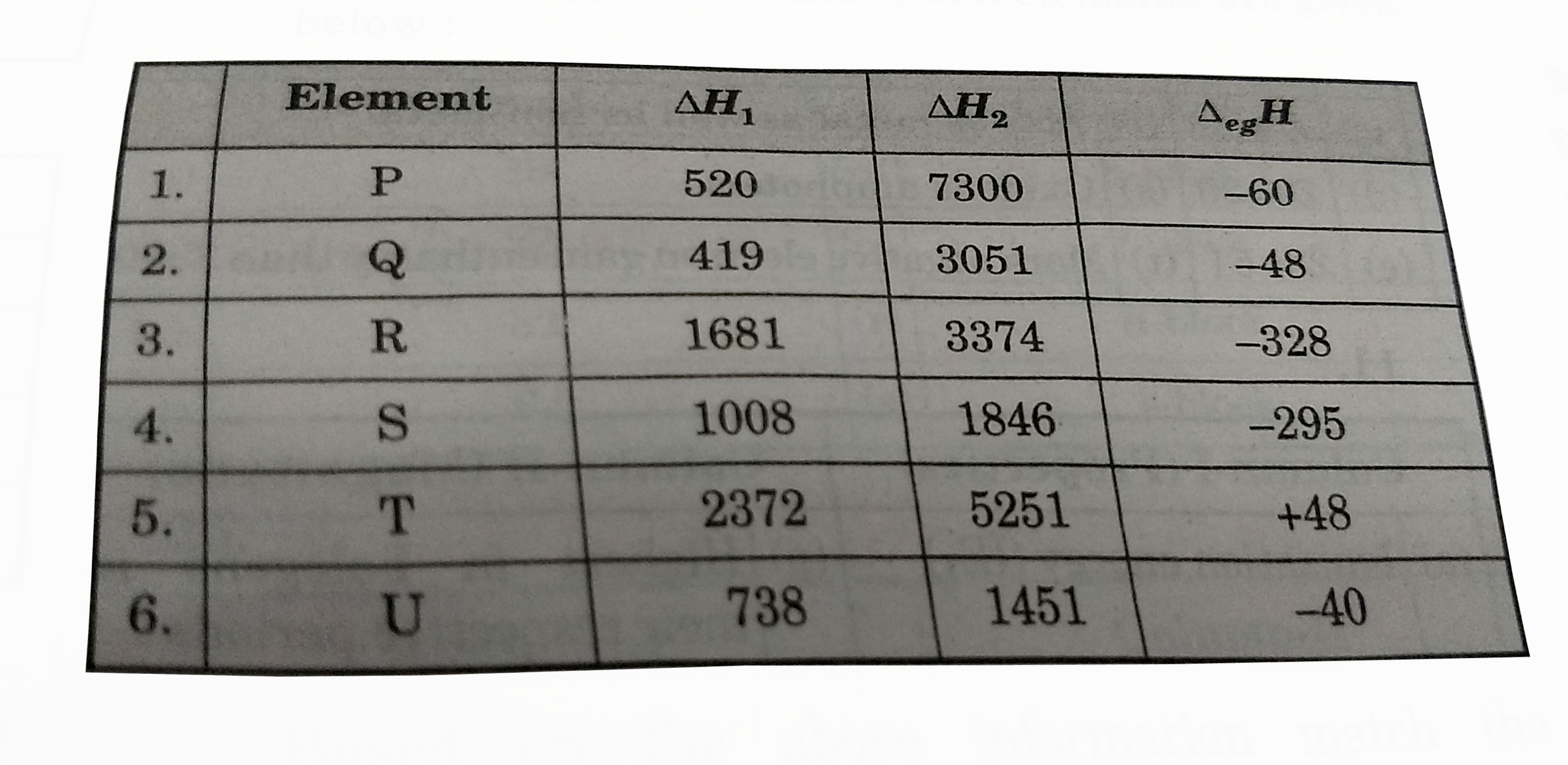
Based on the above information match the following columns.
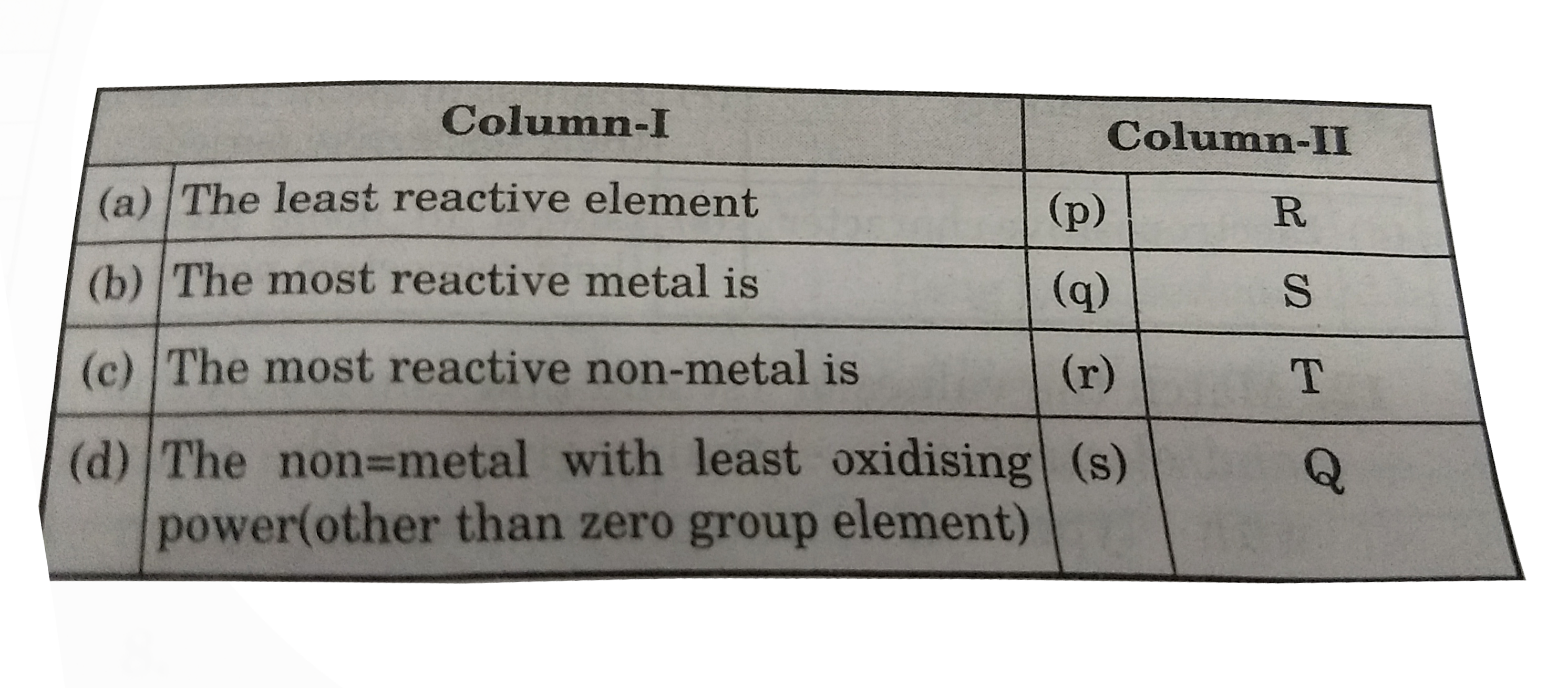
View SolutionThe first (Δi,H1) and the second (Δ,H2) ionisation enthalpies (in kJ mol−1 ) and the (ΔegH) electron gain enthalpy (in kJ mol−1 ) of a few elements are given below :
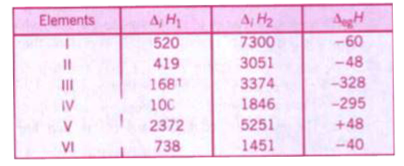
Which of the above elements is likely to be :
a reactive metal
View Solution
Knowledge Check
The first (ΔiH1 and second (ΔiH2 ionization enthalpies (in kJ/mol) and electron gain enthalpy (in kJ/mol) of few elements are given below:
ElementsΔiH1ΔiH2ΔegHI5207300−60II16813374−328III8991757−48IV23725251+48
Which of the following is likely to be an alkali metal?AI and IVBV and IICII and VDIV and VThe first (IE1) and second (IE2) ionisation energies (kJmol−1) of a new elements designated by roman numerals are shown below:
IE1IE2I23705250II5207300III9001800IV17003400
Which of the above elements is likely to be :
a. A reactive metal
b. A reactive non-metal
c. a noble gas
d. A metal that forms a stable binary halide of the formula AX2 (X= the halogen).AI,2372,5251BII,520,7300CIII,900,1760DIV,1680,3380Ionisation enthalpy (ΔtHlinkJmol−1) for the elements of group-13 follows the order
AB>AI>Ga>In>TIBB<AI<Ga<In<TICB<AI>Ga<In>TIDB>AI<Ga>In<TI
The first (Δi,H1) and the second (Δ,H2) ionisation enthalpies (in kJ mol−1 ) and the (ΔegH) electron gain enthalpy (in kJ mol−1 ) of a few elements are given below :
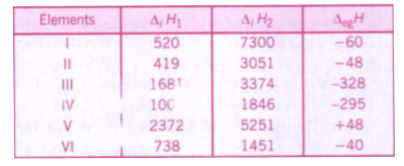
Which of the above elements is likely to be :
the least reactive element?
View SolutionAmong the elements of second period pick out the element
that is the most reactive metal.
View SolutionAmong the elements of second period pick out the element
that is the most reactive non- metal.
View SolutionIonisation enthalpy (ΔiH kJ mol−1) for the elements of group 13 follows the order.
View SolutionThe first (IE1) and the second (IE2) ionisation energies (kJ mol−1) of a few elements are given below :
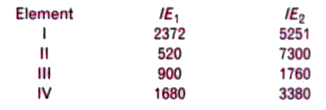
Which of the above elements is likely to be
a reactive metal?
View Solution
